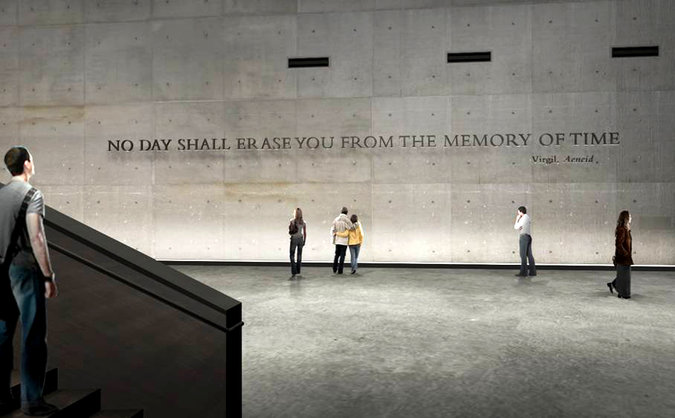By David W. Dunlap New York Times

An early rendering of the inscription at the National September 11 Memorial Museum.
Who are “you”?
When the National September 11 Memorial Museum opens next month at the World Trade Center, visitors will find a stark wall separating them from a repository containing about 8,000 unidentified human remains from the 2001 terrorist attack.
On the wall is a 60-foot-long inscription, in 15-inch letters made from the steel of the twin towers: “No day shall erase you from the memory of time. Virgil.”
It sounds fitting — except in the context of Book 9 of the “Aeneid,” from which it is translated. There, a reader learns who “you” are.
“You” are not nameless. You are Nisus and Euryalus.
“You” do not number in the thousands. You are two.
“You” are not civilians. You are Trojan soldiers.
“You” have not been thrown together by cruel chance. You are a loving pair.
Your deaths are not unprovoked. You have just slaughtered the enemy in an orgy of violence, skewering soldiers whom you ambushed in their sleep. For this, the enemy has killed you and impaled your heads on spears.
Clearly, “you” does not fit the profile of September 11 victims.
“If we take into account its original context, the quotation is more applicable to the aggressors in the 9/11 tragedy than to those honored by the memorial,” said Helen Morales, a classics professor at the University of California at Santa Barbara. “So my first reaction is that the quotation is shockingly inappropriate for the U.S. victims of the 9/11 attack.”
But Dr. Morales added that by invoking the two warriors, the quotation might also productively encourage some visitors to “wonder, as might Virgil’s readers have wondered of Nisus and Euryalus, what drives young men to commit such atrocities.”
I asked a half-dozen classicists about the use of this inscription at the memorial museum. All but one questioned the choice.
“Two warrior/lovers have sacrificed their lives in the interest of the future Roman state,” said John F. Makowski, an associate professor of classical studies at Loyola University in Chicago. “While the loss of all human life by violence is lamentable, the parallel between the victims of 9/11 and the Virgilian heroes is a stretch.”
In an aside to the dead youths — whom Dr. Makowski has argued should be understood as a classical pair of “erastes” (a mentor and role model) and “eromenos” (his beloved) — Virgil promises that if his poetry has any power, their memory will endure as long as Rome.
The National September 11 Memorial and Museum at the World Trade Center Foundation has known for years of classicists’ objections to the use of this line, which “offers neither instruction nor solace,” Caroline Alexander wrote for the Op-Ed page of The New York Times in 2011.
Since then, museum officials have eliminated the word “Aeneid” from the inscription as it appears on the wall, presumably to distance the sentiment somewhat from its literary context.
Alice M. Greenwald, the museum director, said last week that the quotation appropriately characterized the “museum’s overall commemorative context.”
“The quote speaks to the indelibility of our memories,” she said. “In selecting this quote, our focus was not on the specific narrative of the classic story nor its characters. What resonated with us, and with everyone who reviewed its use in the context of the museum, was the reference to a single day not being able to erase the memory of those we love.”
However, Shadi Bartsch-Zimmer, a classics professor at the University of Chicago, suggested that the foundation had a special duty to guard cultural history.
“For a private individual to use a quotation and shrug at its source is one thing,” Dr. Bartsch-Zimmer said. “But in a public, institutional context that memorializes an event of national importance, not knowing one’s source seems irresponsible.”
While acknowledging his ambivalence about the use of the line, Llewelyn Morgan, a lecturer in classical languages and literature at Oxford, allowed that its power was not limited to those who knew the story told in the “Aeneid.”
“I can see that this might do the job required,” Dr. Morgan said, “and it’s perhaps a little arrogant to think that the proper perspective from which to assess it is my own, that of an academic. We don’t own Virgil, much as we might think we should.”
James Zetzel, a professor of the Latin language and literature at Columbia, said he was troubled by a line describing such specific characters — and “not the best role models” — used as a kind of epitaph for those whose identities are not known.
“On the other hand,” Mr. Zetzel said, “the story is an example of willing self-sacrifice for somebody you love.”
As Virgil tells it, Nisus realized as he was fleeing from the enemy that he had been separated from Euryalus. Rather than spare himself, Nisus returned to a scene of mortal peril in the hope of saving another’s life. Both young men died as a result.
Now that sounds like a 9/11 story.

